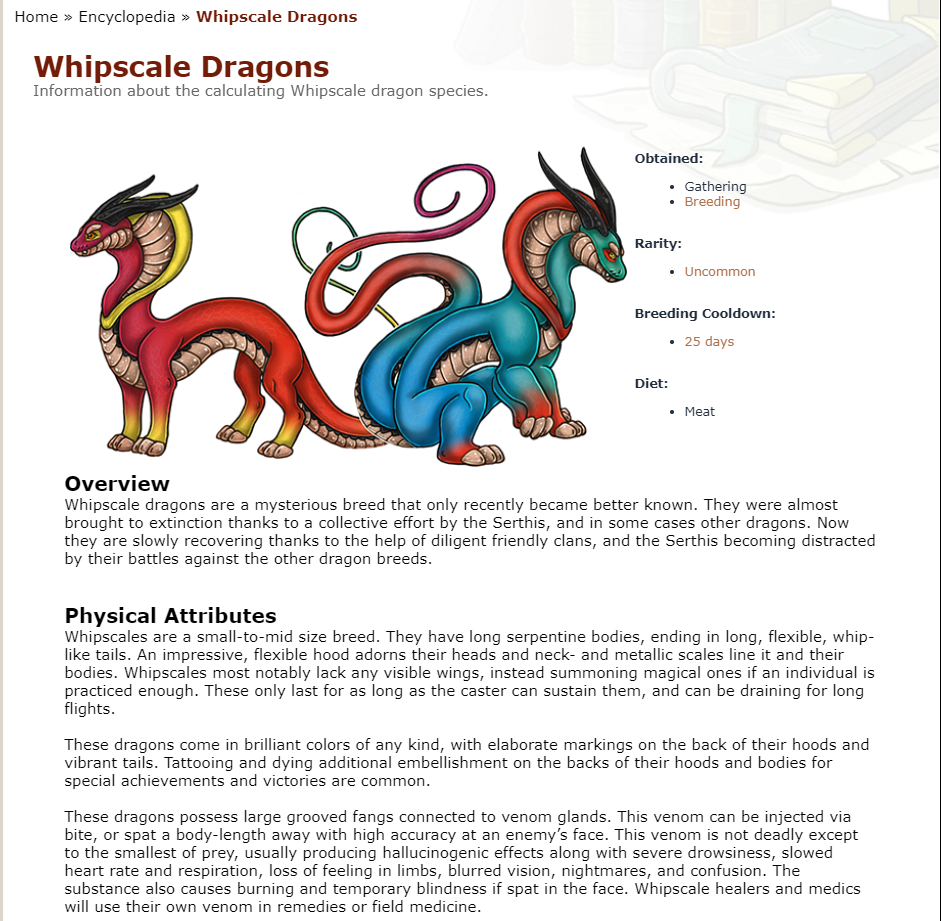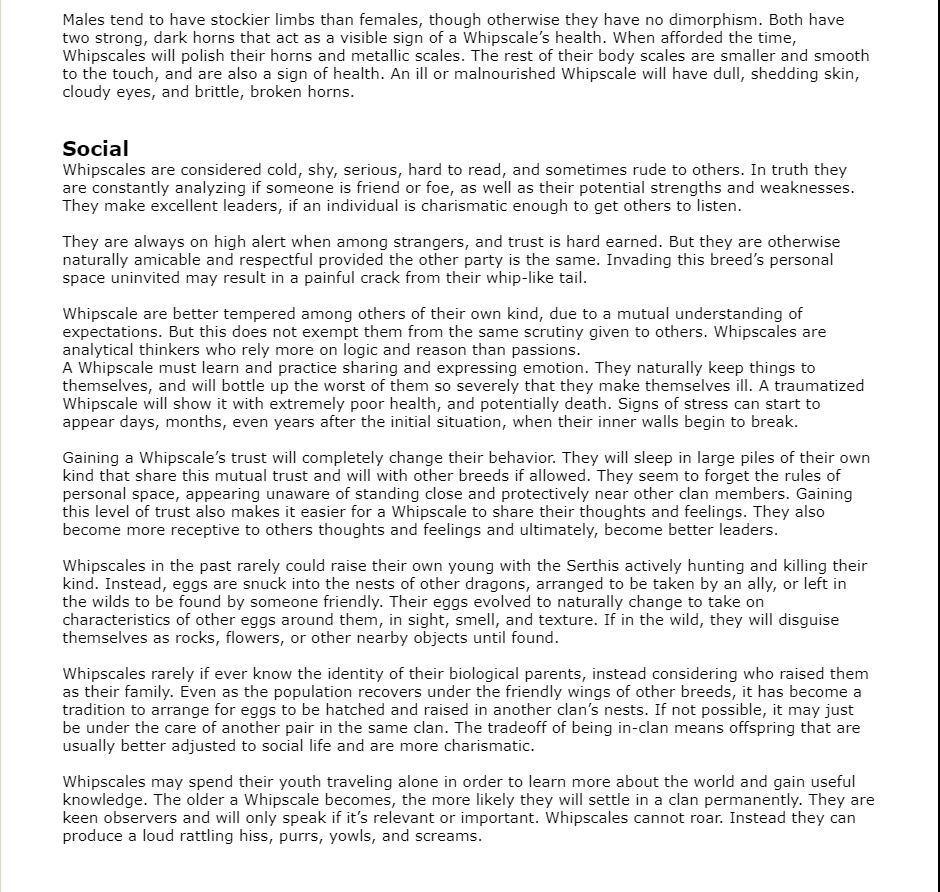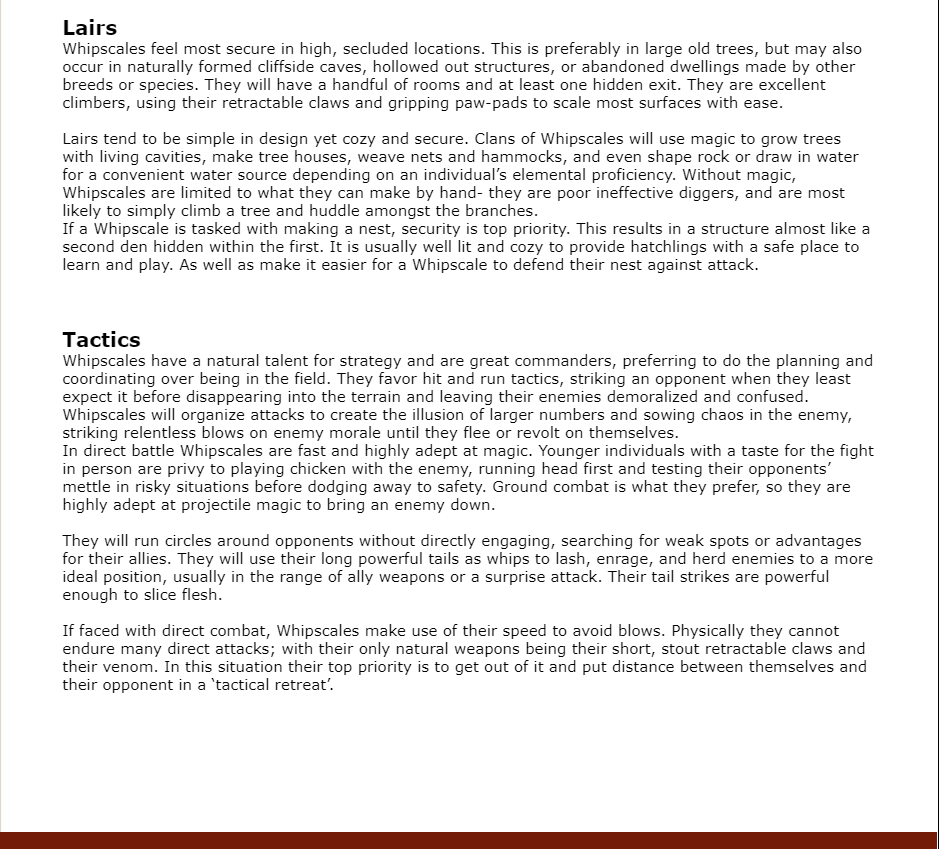Whipscale dragons are a mysterious breed that only recently became better known. They were almost brought to extinction thanks to a collective effort by the Serthis, and in some cases other dragons. Now they are slowly recovering thanks to the help of diligent friendly clans, and the Serthis becoming distracted by their battles against the other dragon breeds.
These dragons come in brilliant colors of any kind, with elaborate markings on the back of their hoods and vibrant tails. Tattooing and dying additional embellishment on the backs of their hoods and bodies for special achievements and victories are common.
These dragons possess large grooved fangs connected to venom glands. This venom can be injected via bite, or spat a body-length away with high accuracy at an enemy’s face. This venom is not deadly except to the smallest of prey, usually producing hallucinogenic effects along with severe drowsiness, slowed heart rate and respiration, loss of feeling in limbs, blurred vision, nightmares, and confusion. The substance also causes burning and temporary blindness if spat in the face. Whipscale healers and medics will use their own venom in remedies or field medicine.
Males tend to have stockier limbs than females, though otherwise they have no dimorphism. Both have two strong, dark horns that act as a visible sign of a Whipscale’s health. When afforded the time, Whipscales will polish their horns and metallic scales. The rest of their body scales are smaller and smooth to the touch, and are also a sign of health. An ill or malnourished Whipscale will have dull, shedding skin, cloudy eyes, and brittle, broken horns.
They are always on high alert when among strangers, and trust is hard earned. But they are otherwise naturally amicable and respectful provided the other party is the same. Invading this breed’s personal space uninvited may result in a painful crack from their whip-like tail.
Whipscale are better tempered among others of their own kind, due to a mutual understanding of expectations. But this does not exempt them from the same scrutiny given to others. Whipscales are analytical thinkers who rely more on logic and reason than passions.
A Whipscale must learn and practice sharing and expressing emotion. They naturally keep things to themselves, and will bottle up the worst of them so severely that they make themselves ill. A traumatized Whipscale will show it with extremely poor health, and potentially death. Signs of stress can start to appear days, months, even years after the initial situation, when their inner walls begin to break.
Gaining a Whipscale’s trust will completely change their behavior. They will sleep in large piles of their own kind that share this mutual trust and will with other breeds if allowed. They seem to forget the rules of personal space, appearing unaware of standing close and protectively near other clan members. Gaining this level of trust also makes it easier for a Whipscale to share their thoughts and feelings. They also become more receptive to others thoughts and feelings and ultimately, become better leaders.
Whipscales in the past rarely could raise their own young with the Serthis actively hunting and killing their kind. Instead, eggs are snuck into the nests of other dragons, arranged to be taken by an ally, or left in the wilds to be found by someone friendly. Their eggs evolved to naturally change to take on characteristics of other eggs around them, in sight, smell, and texture. If in the wild, they will disguise themselves as rocks, flowers, or other nearby objects until found.
Whipscales rarely if ever know the identity of their biological parents, instead considering who raised them as their family. Even as the population recovers under the friendly wings of other breeds, it has become a tradition to arrange for eggs to be hatched and raised in another clan’s nests. If not possible, it may just be under the care of another pair in the same clan. The tradeoff of being in-clan means offspring that are usually better adjusted to social life and are more charismatic.
Whipscales may spend their youth traveling alone in order to learn more about the world and gain useful knowledge. The older a Whipscale becomes, the more likely they will settle in a clan permanently. They are keen observers and will only speak if it’s relevant or important. Whipscales cannot roar. Instead they can produce a loud rattling hiss, purrs, yowls, and screams.
Lairs tend to be simple in design yet cozy and secure. Clans of Whipscales will use magic to grow trees with living cavities, make tree houses, weave nets and hammocks, and even shape rock or draw in water for a convenient water source depending on an individual’s elemental proficiency. Without magic, Whipscales are limited to what they can make by hand- they are poor ineffective diggers, and are most likely to simply climb a tree and huddle amongst the branches.
If a Whipscale is tasked with making a nest, security is top priority. This results in a structure almost like a second den hidden within the first. It is usually well lit and cozy to provide hatchlings with a safe place to learn and play. As well as make it easier for a Whipscale to defend their nest against attack.
In direct battle Whipscales are fast and highly adept at magic. Younger individuals with a taste for the fight in person are privy to playing chicken with the enemy, running head first and testing their opponents’ mettle in risky situations before dodging away to safety. Ground combat is what they prefer, so they are highly adept at projectile magic to bring an enemy down.
They will run circles around opponents without directly engaging, searching for weak spots or advantages for their allies. They will use their long powerful tails as whips to lash, enrage, and herd enemies to a more ideal position, usually in the range of ally weapons or a surprise attack. Their tail strikes are powerful enough to slice flesh.
If faced with direct combat, Whipscales make use of their speed to avoid blows. Physically they cannot endure many direct attacks; with their only natural weapons being their short, stout retractable claws and their venom. In this situation their top priority is to get out of it and put distance between themselves and their opponent in a ‘tactical retreat’.
.
Physical Attributes
.
Whipscales are a small-to-mid size breed. They have long serpentine bodies, ending in long, flexible, whip-like tails. An impressive, flexible hood adorns their heads and neck- and metallic scales line it and their bodies. Whipscales most notably lack any visible wings, instead summoning magical ones if an individual is practiced enough. These only last for as long as the caster can sustain them, and can be draining for long flights.Physical Attributes
.
These dragons come in brilliant colors of any kind, with elaborate markings on the back of their hoods and vibrant tails. Tattooing and dying additional embellishment on the backs of their hoods and bodies for special achievements and victories are common.
These dragons possess large grooved fangs connected to venom glands. This venom can be injected via bite, or spat a body-length away with high accuracy at an enemy’s face. This venom is not deadly except to the smallest of prey, usually producing hallucinogenic effects along with severe drowsiness, slowed heart rate and respiration, loss of feeling in limbs, blurred vision, nightmares, and confusion. The substance also causes burning and temporary blindness if spat in the face. Whipscale healers and medics will use their own venom in remedies or field medicine.
Males tend to have stockier limbs than females, though otherwise they have no dimorphism. Both have two strong, dark horns that act as a visible sign of a Whipscale’s health. When afforded the time, Whipscales will polish their horns and metallic scales. The rest of their body scales are smaller and smooth to the touch, and are also a sign of health. An ill or malnourished Whipscale will have dull, shedding skin, cloudy eyes, and brittle, broken horns.
.
Social
.
Whipscales are considered cold, shy, serious, hard to read, and sometimes rude to others. In truth they are constantly analyzing if someone is friend or foe, as well as their potential strengths and weaknesses. They make excellent leaders, if an individual is charismatic enough to get others to listen.Social
.
They are always on high alert when among strangers, and trust is hard earned. But they are otherwise naturally amicable and respectful provided the other party is the same. Invading this breed’s personal space uninvited may result in a painful crack from their whip-like tail.
Whipscale are better tempered among others of their own kind, due to a mutual understanding of expectations. But this does not exempt them from the same scrutiny given to others. Whipscales are analytical thinkers who rely more on logic and reason than passions.
A Whipscale must learn and practice sharing and expressing emotion. They naturally keep things to themselves, and will bottle up the worst of them so severely that they make themselves ill. A traumatized Whipscale will show it with extremely poor health, and potentially death. Signs of stress can start to appear days, months, even years after the initial situation, when their inner walls begin to break.
Gaining a Whipscale’s trust will completely change their behavior. They will sleep in large piles of their own kind that share this mutual trust and will with other breeds if allowed. They seem to forget the rules of personal space, appearing unaware of standing close and protectively near other clan members. Gaining this level of trust also makes it easier for a Whipscale to share their thoughts and feelings. They also become more receptive to others thoughts and feelings and ultimately, become better leaders.
Whipscales in the past rarely could raise their own young with the Serthis actively hunting and killing their kind. Instead, eggs are snuck into the nests of other dragons, arranged to be taken by an ally, or left in the wilds to be found by someone friendly. Their eggs evolved to naturally change to take on characteristics of other eggs around them, in sight, smell, and texture. If in the wild, they will disguise themselves as rocks, flowers, or other nearby objects until found.
Whipscales rarely if ever know the identity of their biological parents, instead considering who raised them as their family. Even as the population recovers under the friendly wings of other breeds, it has become a tradition to arrange for eggs to be hatched and raised in another clan’s nests. If not possible, it may just be under the care of another pair in the same clan. The tradeoff of being in-clan means offspring that are usually better adjusted to social life and are more charismatic.
Whipscales may spend their youth traveling alone in order to learn more about the world and gain useful knowledge. The older a Whipscale becomes, the more likely they will settle in a clan permanently. They are keen observers and will only speak if it’s relevant or important. Whipscales cannot roar. Instead they can produce a loud rattling hiss, purrs, yowls, and screams.
.
Lairs
.
Whipscales feel most secure in high, secluded locations. This is preferably in large old trees, but may also occur in naturally formed cliffside caves, hollowed out structures, or abandoned dwellings made by other breeds or species. They will have a handful of rooms and at least one hidden exit. They are excellent climbers, using their retractable claws and gripping paw-pads to scale most surfaces with ease.Lairs
.
Lairs tend to be simple in design yet cozy and secure. Clans of Whipscales will use magic to grow trees with living cavities, make tree houses, weave nets and hammocks, and even shape rock or draw in water for a convenient water source depending on an individual’s elemental proficiency. Without magic, Whipscales are limited to what they can make by hand- they are poor ineffective diggers, and are most likely to simply climb a tree and huddle amongst the branches.
If a Whipscale is tasked with making a nest, security is top priority. This results in a structure almost like a second den hidden within the first. It is usually well lit and cozy to provide hatchlings with a safe place to learn and play. As well as make it easier for a Whipscale to defend their nest against attack.
.
Tactics
.
Whipscales have a natural talent for strategy and are great commanders, preferring to do the planning and coordinating over being in the field. They favor hit and run tactics, striking an opponent when they least expect it before disappearing into the terrain and leaving their enemies demoralized and confused. Whipscales will organize attacks to create the illusion of larger numbers and sowing chaos in the enemy, striking relentless blows on enemy morale until they flee or revolt on themselves.Tactics
.
In direct battle Whipscales are fast and highly adept at magic. Younger individuals with a taste for the fight in person are privy to playing chicken with the enemy, running head first and testing their opponents’ mettle in risky situations before dodging away to safety. Ground combat is what they prefer, so they are highly adept at projectile magic to bring an enemy down.
They will run circles around opponents without directly engaging, searching for weak spots or advantages for their allies. They will use their long powerful tails as whips to lash, enrage, and herd enemies to a more ideal position, usually in the range of ally weapons or a surprise attack. Their tail strikes are powerful enough to slice flesh.
If faced with direct combat, Whipscales make use of their speed to avoid blows. Physically they cannot endure many direct attacks; with their only natural weapons being their short, stout retractable claws and their venom. In this situation their top priority is to get out of it and put distance between themselves and their opponent in a ‘tactical retreat’.



















